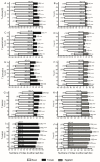Phylogenetic-Related Divergence in Perceiving Suitable Host Plants among Five Spider Mites Species (Acari: Tetranychidae)
- PMID: 36005330
- PMCID: PMC9409760
- DOI: 10.3390/insects13080705
Phylogenetic-Related Divergence in Perceiving Suitable Host Plants among Five Spider Mites Species (Acari: Tetranychidae)
Abstract
Spider mites belonging to the genus Tetranychus infest many important agricultural crops in both fields and greenhouses worldwide and are diversified in their host plant range. How spider mites perceive their suitable host plants remains not completely clear. Here, through two-host-choice designs (bean vs. tomato, and bean vs. eggplant), we tested the efficacies of the olfactory and gustatory systems of five spider mite species (T. urticae, T. truncatus, T. pueraricola, T. piercei, and T. evansi), which differ in host plant range in sensing their suitable host plant, by Y-tube olfactometer and two-choice disc experiments. We found that spider mites cannot locate their suitable host plants by volatile odours from a long distance, but they can use olfactory sensation in combination with gustatory sensation to select suitable host plants at a short distance. Highly polyphagous species displayed strong sensitivity in sensing suitable host plants rather than the lowered sensitivity we expected. Intriguingly, our principal component analyses (PCAs) showed that the similarity among five spider mite species in the performance of perceiving suitable host plants was highly correlated with their relative phylogenetic relationships, suggesting a close relationship between the chemosensing system and the speciation of spider mites. Our results highlight the necessity of further work on the chemosensing system in relation to host plant range and speciation of spider mites.
Keywords: Y-tube olfactometer; chemosensing system; feeding preference; two-choice disc.
Conflict of interest statement
The authors declare no conflict of interest.
Figures




Similar articles
-
The effect of host plants on Tetranychus evansi, Tetranychus urticae (Acari: Tetranychidae) and on their fungal pathogen Neozygites floridana (Entomophthorales: Neozygitaceae).J Invertebr Pathol. 2011 Jun;107(2):139-45. doi: 10.1016/j.jip.2011.04.003. Epub 2011 Apr 13. J Invertebr Pathol. 2011. PMID: 21510956
-
A multiplex direct PCR method for the rapid and accurate discrimination of three species of spider mites (Acari: Tetranychidae) in fruit orchards in Beijing.Exp Appl Acarol. 2024 Apr;92(3):403-421. doi: 10.1007/s10493-023-00900-5. Epub 2024 Mar 15. Exp Appl Acarol. 2024. PMID: 38489086
-
The invasive spider mite Tetranychus evansi (Acari: Tetranychidae) alters community composition and host-plant use of native relatives.Exp Appl Acarol. 2013 Jul;60(3):321-41. doi: 10.1007/s10493-012-9645-7. Epub 2012 Dec 13. Exp Appl Acarol. 2013. PMID: 23238959
-
Can Plant Defence Mechanisms Provide New Approaches for the Sustainable Control of the Two-Spotted Spider Mite Tetranychus urticae?Int J Mol Sci. 2018 Feb 21;19(2):614. doi: 10.3390/ijms19020614. Int J Mol Sci. 2018. PMID: 29466295 Free PMC article. Review.
-
Spider-mite problems and control in Taiwan.Exp Appl Acarol. 2000;24(5-6):453-62. doi: 10.1023/a:1006443619632. Exp Appl Acarol. 2000. PMID: 11156169 Review.
Cited by
-
A chromosome-level genome assembly of the spider mite Tetranychus piercei McGregor.Sci Data. 2024 Apr 5;11(1):340. doi: 10.1038/s41597-024-03189-0. Sci Data. 2024. PMID: 38580722 Free PMC article.
References
-
- Migeon A., Dorkeld F. A Comprehensive Database for the Tetranychidae; Montpellier. 2015. [(accessed on 28 July 2022)]. Available online: http://www1.montpellier.inra.fr/CBGP/spmweb.
-
- Jin P.Y., Tian L., Chen L., Hong X.Y. Spider mites of agricultural importance in China, with focus on species composition during the last decade (2008–2017) Syst. Appl. Acarol. 2018;23:2087–2098. doi: 10.11158/saa.23.11.1. - DOI
LinkOut - more resources
Full Text Sources

